#Smart Factory
Explore tagged Tumblr posts
Text
https://glansa.com/andon/
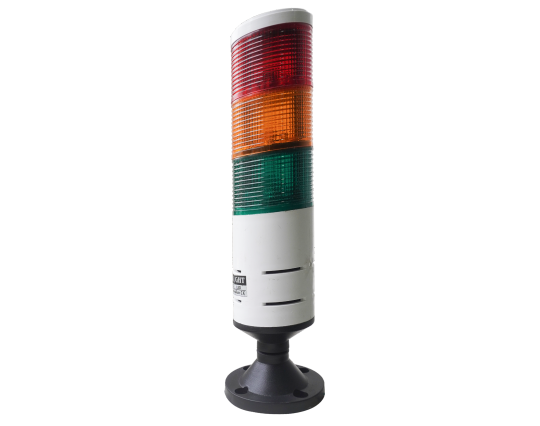
Discover how Industry Automation in India is revolutionizing manufacturing with smart solutions like Andon systems. Glansa Solutions offers a real-time alert and monitoring system to reduce downtime, improve efficiency, and support Industry 4.0 implementation. Explore how Indian industries are leveraging automation to stay globally competitive.
#Industry Automation in India#Andon System#Manufacturing Automation#Industrial Solutions India#Smart Factory#Glansa Andon#Industry 4.0 India#Real-time Production Monitoring
0 notes
Text
Digital Problem Solving in Factories: Is the ROI Worth the Transition?
Everyone’s talking about digitalization in factories, but what does that actually mean when it comes to solving real problems on the shop floor? One of the biggest—and most impactful—changes is the shift from paper-based problem solving to digital, automated systems. But let’s be honest: change is hard. Transitioning from forms, binders, and spreadsheets to a structured faster problem solving software can feel overwhelming.
So… is it really worth the time, cost, and cultural change? In this blog, we’ll break down exactly why moving from paper to digital isn't just a trend—it's a logical and high-ROI move that enhances speed, quality, compliance, and visibility across the entire factory.
What’s Wrong with Traditional Problem Solving?
Despite decades of use, traditional problem-solving methods in factories are cracking under modern demands. Manufacturers still rely on paper forms, Excel logs, and siloed discussions to document, track, and solve problems. But these methods were designed for a slower, less complex world.
Today’s factories move faster, produce more variants, and face tighter compliance and quality requirements. Everyone is pushing for change because traditional tools don’t support speed, accountability, or real-time decision-making. Let’s look at why these methods fall short:
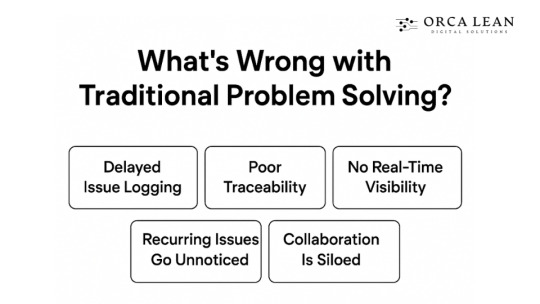
Let’s break down what’s going wrong:
1. Delayed Issue Logging - By the time an operator fills a paper form or logs a defect on Excel, the problem has already spread. Manual entries introduce delays and human error, which slows everything down.
2. Poor Traceability - Once you start hunting for a paper report from last month, you’ve already lost the battle. Traditional systems lack transparency into who reported what, when, and what action was taken.
3. No Real-Time Visibility - Supervisors and managers only see problems when someone brings them up in a meeting—by then, it’s often too late. Without live tracking, problems escalate silently.
4. Recurring Issues Go Unnoticed - When issues are solved in isolation, without centralized tracking, teams end up fixing the same problem again and again.
5. Collaboration Is Siloed - Operators write it down. Supervisors report it. Engineering looks into it later. This delay between departments kills response time.
Explore how digital transformation directly improves quality outcomes in our detailed guide: Impact of Digital Transformation on Quality Management
What Digital Problem Solving Actually Changes?
Digital problem solving is not about simply replacing paper with screens. It’s a shift in how factories identify, escalate, analyze, and eliminate issues. Traditional methods are reactive and fragmented. Digital tools are proactive, centralized, and insight-driven. This transition helps manufacturers move from “firefighting mode” to a culture of continuous improvement.
Here’s what changes when you adopt the right manufacturing software for problem solving:
A. Speed
Digital tools enable real-time issue logging from the shop floor—whether via tablets, kiosks, or operator dashboards. The moment a problem is entered, it’s automatically routed to the right team based on category, severity, or asset. This eliminates waiting for emails, meetings, or paper forms to reach supervisors.
B. Transparency
A digital platform provides a full audit trail. Every action taken—from issue creation to root cause analysis to final resolution—is time-stamped and visible to stakeholders. There’s no confusion over who did what or when. This transparency improves cross-functional trust and strengthens compliance tracking for ISO, IATF, and other industry audits.
Want to see how digital records outperform paper logs? Read our breakdown:Paper vs Digital Data Acquisition in Manufacturing
C. Data-Driven Insights
Digital problem-solving platforms don’t just track problems—they analyze them. They reveal repeat failures, identify top contributors by line or shift, and link problems to KPIs like scrap rate or downtime. These insights enable smarter prioritization and preventive action.
D. Team Alignment
Digital tools create shared visibility. When teams across shifts or departments see the same dashboard, handovers become seamless. Engineering, quality, and production can all contribute to the same issue without delays or duplicated work. Real-time collaboration fosters accountability and faster resolutions.
Want to explore how quality inspection helps manufacturers? Check our blog to dive into the details.
E. Centralized Knowledge Base
Instead of tribal knowledge or scattered spreadsheets, you build a growing, searchable library of past problems, tools used, actions taken, and lessons learned. This benefits new hires, supports standardization, and prevents repeated mistakes.
Digitalization in factories isn’t about bells and whistles. It’s about using software for factory workflows to enable faster, smarter, and more consistent problem solving—turning everyday issues into opportunities for growth.
But Isn’t Digitalization for Factories Difficult?
Of course it is. Change is uncomfortable—especially in factories where operators have used the same paper forms for years. But what’s often labeled as a “tech problem” is usually just a mindset shift. And mindset can be changed—with the right approach.
Start small - Don’t digitize your whole plant on day one. Begin with one production line, one shift, or one recurring issue. Prove value in a focused area, then expand. Small wins build big momentum.
Pick the right software - If your digital tool feels like it was built only for engineers, your operators will resist it. Choose faster problem solving software designed for frontline ease—tap, log, assign. No confusion. No coding. No frustration.
Make quick wins visible - People don’t rally behind technology—they rally behind results. If a defect was resolved in half the time last week, share it. Announce it on the floor. Show it on a dashboard. Let the improvement speak louder than the software.
Train, but don’t overtrain - Digitalization doesn’t require a master's degree. Short, hands-on training with real factory use cases works better than manuals. Keep it contextual, keep it relevant.
Show the story through dashboards - Dashboards turn numbers into proof. When teams see improvement live, belief follows. Metrics don’t lie.
Here’s the simple truth: your teams are already solving problems. Software just helps them do it faster, better, and visibly. That’s not disruption. That’s evolution.
Curious about how to start? Check out our 7 FAQs About Transitioning from Paper to Digital in Manufacturing to get practical answers before you take the leap.
Is the Adoption Journey Worth It?
Implementing digitalization in factory operations brings its share of doubts: “It takes too long,” “operators won’t adopt it,” “it’s too expensive.” And those concerns aren’t baseless—rollouts involve training, process tweaks, and upfront investment. But clinging to paper and spreadsheets carries hidden costs: delayed fixes, repeated defects, and firefighting modes that erode margins. Despite the challenges, the adoption journey pays dividends in efficiency, quality, and culture—making every hurdle a worthwhile investment.
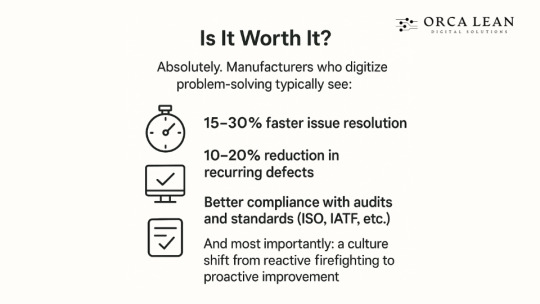
Real Impact: What You Can Expect to Improve
Digital problem-solving isn’t about theory—it’s about real, trackable results. When manufacturers shift from paper to structured, software-driven processes, they unlock tangible improvements across quality, efficiency, compliance, and culture. The ROI becomes visible not in quarters, but in weeks. Here’s what companies typically experience after implementing faster problem solving software like Solvonext:
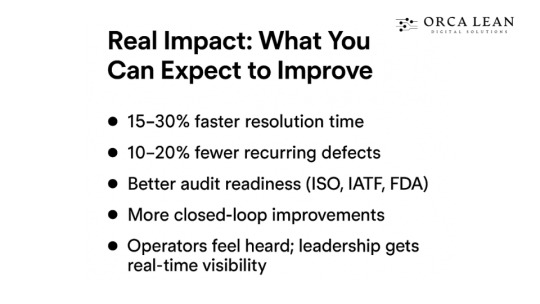
Conclusion
You’re already solving problems—every shift, every day. But if you're still relying on paper, you're solving them slower, with less visibility and more waste. Paper systems were built for yesterday.
Today’s factories need speed, traceability, and actionable insights—and that’s exactly what digital problem-solving delivers. The return isn’t just in faster resolutions—it’s in fewer defects, stronger audits, and a culture of continuous improvement.
Solvonext helps you make that leap—without disruption. With built-in tools, real-time tracking, and frontline-ready design, it's everything your team needs to solve smarter.
Book a Demo today and explore Solvonext: your next step to operational excellence.
1 note
·
View note
Text
CNC Machine Manufacturer in India
Looking for a reliable CNC machine manufacturer in India? Discover high-quality, precision-engineered CNC machines that power industries across automotive, aerospace, electronics, and more. Indian CNC machine manufacturers have quickly emerged as global leaders, offering advanced, affordable, and durable solutions for both small businesses and large-scale industries.
One of the standout names in the Indian CNC sector is Sahil Machines. Known for their innovation and commitment to quality, Sahil Machines provides a wide range of CNC solutions, including CNC turning centers, vertical machining centers (VMC), and custom-built systems. Their machines are designed for accuracy, speed, and longevity—making them ideal for high-demand applications.
With strong after-sales service, installation support, and training, Indian CNC machine manufacturers ensure that your production lines stay efficient and productive. Whether you're a startup or an established industry player, choosing a trusted Indian manufacturer helps reduce costs without compromising on performance.
Many manufacturers now also offer smart features like IoT integration, real-time monitoring, and automated production capabilities—ensuring you stay ahead in a competitive market.
Bookmark this page if you’re planning to invest in reliable CNC machinery made in India. Experience engineering excellence, world-class support, and unbeatable value with top CNC brands from India.
0 notes
Text
youtube
Sandy Munro reveals why Chinese Car companies are 5 years ahead
🚗 In this eye-opening video, legendary automotive engineer Sandy Munro breaks down why Chinese car companies are now 5 years ahead of global competitors in the EV revolution! From groundbreaking battery technology, manufacturing efficiency, and cutting-edge design, to game-changing strategies in electric vehicles, Munro exposes how brands like BYD, NIO, Xpeng, and Li Auto are dominating the future of electric cars. Discover how China's EV innovation, supply chain control, and smart factory integration are reshaping the automotive industry faster than Tesla and legacy automakers ever imagined. Don’t miss this deep dive into the global shift in EV leadership, and find out what it means for the future of electric mobility, autonomous driving, and sustainable transportation.
#Sandy Munro#smart factory#ev manufacturing#ev sales#american decline#competition#BYD#Youtube#tesla killer#elon musk#China#usa
1 note
·
View note
Text
Industry 4.0: Powering the Next Industrial Revolution with Intelligence, Connectivity, and Automation
The world is undergoing a radical transformation. As we move deeper into the 21st century, the fusion of digital, physical, and biological systems is reshaping how we manufacture, operate, and innovate. This revolution has a name: Industry 4.0—the fourth industrial revolution. It represents a new era where smart technology, real-time data, automation, and interconnected networks converge to…
#5G Connectivity#Additive Manufacturing#advanced robotics#Artificial intelligence#Automation#Big Data Analytics#Blockchain#Cloud Computing#connected industry#Cyber-physical systems#data-driven operations#Digital Transformation#Digital twin#Edge computing#fourth industrial revolution#IIoT#Industrial Networking#Industry 4.0#intelligent systems#manufacturing innovation#next-gen industry#Predictive maintenance#Real-time analytics#Robotics#smart factory#Smart Grid#Smart logistics#Smart manufacturing#SolveForce#Supply Chain Visibility
0 notes
Text
Odoo ERP for Manufacturing Industry
🏭 Manufacturers—streamline your operations with Odoo ERP!
From production planning to inventory management and real-time reporting, Odoo gives you full control of your manufacturing process — all in one platform.
✅ Boost productivity ✅ Minimize downtime ✅ Reduce waste & costs ✅ Get real-time insights for smarter decisions
Looking to digitize your factory floor? Our team specializes in implementing Odoo ERP tailored for the manufacturing industry.
🔧 Explore how we can help: https://www.candidroot.com/odoo-manufacturing-erp
#odoo#odoo erp#erp for manufacturing#manufacturing excellence#smart factory#industry 40#digital manufacturing#erpsoftware#erp system
0 notes
Text
Smart Factory Market to Hit $30.1 Billion by 2029: The Future of Manufacturing is Here

The smart factory market is undergoing a rapid transformation, driven by a blend of advanced technologies, robust government support, and the rising demand for efficient, automated production processes. According to a recent report by MarketsandMarkets™, the smart factory market is expected to surge from $18.8 billion in 2024 to $30.1 billion by 2029, growing at an impressive CAGR of 9.8%.
This growth reflects a major shift in how industries operate, moving from traditional manufacturing to connected, intelligent, and automated ecosystems. The smart factory revolution is well underway, and industries are leading the charge.
What’s Fueling the Smart Factory Boom?
Several factors are contributing to this explosive market growth
1. Advanced Technology Adoption
The rapid implementation of Industry 4.0 technologies, including IoT, AI, machine learning, and 3D printing, is transforming the industrial landscape. Manufacturers are using real-time data, automation, and smart systems to improve efficiency, reduce costs, and enhance product quality.
2. Strong Government Support
The government has created a favorable environment for innovation, funding R&D initiatives, and pushing for the adoption of digital manufacturing technologies across sectors. Programs such as Manufacturing USA are key enablers, accelerating the transition to smarter, more agile manufacturing processes.
3. Focus on Operational Efficiency
Increased pressure to optimize resource usage, reduce downtime, and ensure product traceability is driving companies to adopt smart factory solutions. By digitizing workflows, factories can enhance responsiveness and quality while maintaining cost-effectiveness.
Key Segments Leading the Market Growth
The report highlights several crucial components and solutions that are powering the smart factory boom in the
1. Industrial Sensors
In 2023, industrial sensors captured a significant share of the market. These sensors are critical for monitoring machinery, detecting anomalies, and collecting real-time data. As factories become smarter, sensors enable predictive maintenance, process optimization, and real-time decision-making.
Driven by the Internet of Things (IoT), the adoption of smarter sensors helps manufacturers reduce waste, enhance safety, and remain competitive in an increasingly digital ecosystem.
2. Industrial 3D Printing
Industrial 3D printing is projected to register the highest CAGR during the forecast period. This technology plays a vital role in enabling rapid prototyping, on-demand production, and customization. With strong demand from aerospace, automotive, and medical device industries, 3D printing is becoming a core component of smart manufacturing.
The benefits from a rich base of technological infrastructure and a skilled workforce make it a global leader in 3D printing adoption.
3. Manufacturing Execution Systems (MES)
MES solutions are expected to hold a significant share of the smart factory market. MES bridges the gap between factory floor operations and enterprise systems, ensuring that data flows seamlessly and efficiently.
With real-time visibility into production activities, MES helps manufacturers manage resources, monitor performance, and make informed decisions. It’s especially valuable in industries like pharmaceuticals, automotive, and electronics, where precision and compliance are essential.
Market Opportunities and Challenges
Opportunities
Increased investments in AI, robotics, and IoT
Government support for digital infrastructure
Rising need for mass customization
Adoption of cloud platforms and edge computing
These trends are unlocking new possibilities, allowing manufacturers to innovate faster, reduce operational costs, and maintain global competitiveness.
Challenges
While the outlook is positive, the smart factory market faces notable hurdles
High upfront costs for advanced technologies and infrastructure
Integration challenges with legacy systems
Cybersecurity concerns due to increased connectivity
Shortage of skilled labor for operating and maintaining smart systems
Companies must address these challenges with thoughtful planning, training programs, and robust cybersecurity strategies.
Leading Market Players
The smart factory ecosystem is supported by prominent industry leaders, including
Emerson Electric Co.
General Electric
Honeywell International Inc.
Rockwell Automation, Inc.
Dwyer Instruments, LLC.
Stratasys
3D Systems Corporation
These companies are pushing the envelope by developing innovative hardware and software solutions that form the backbone of modern smart factories.
Conclusion: The Future is Automated and Intelligent
The growth of the smart factory market signals a broader transformation in the way goods are designed, produced, and delivered. From smart sensors and 3D printers to MES platforms and predictive analytics, smart factories are at the heart of the next industrial revolution.
To stay ahead, businesses must embrace these changes and invest in digital transformation. With the right strategy and technology, the future of manufacturing looks smarter, faster, and more resilient than ever.
#digital transformation#smart factory#manufacturing industry#automated production processes#monitoring machinery#thirdeye ai#ai
1 note
·
View note
Text
Interwork Software Solutions provides comprehensive Industry 4.0 solutions, integrating advanced technologies like IoT, AI, blockchain, and data analytics to enhance operational efficiency, drive automation, and support digital transformation across industries, fostering sustainable, smart, and connected business ecosystems.
0 notes
Text
How Andon Devices Improve Manufacturing Efficiency – A Smart Factory Essential

Introduction
In today’s competitive manufacturing landscape, operational efficiency and real-time communication are critical. As factories move toward Industry 4.0, tools like the Andon device are becoming essential for lean production environments. An Andon system serves as an immediate visual and/or audible alert mechanism that highlights issues on the shop floor, enabling faster response times and reducing costly downtimes.
What is an Andon Device?
An Andon device is a signal system used in industrial settings to alert operators, supervisors, or maintenance teams about problems or abnormalities in real time. Traditionally, Andon systems were simple light signals. However, modern solutions—like those offered by Glansa Solutions—come with digital displays, IoT integration, and real-time data tracking.
Why Use an Andon Device?
Real-Time Communication: Operators can immediately alert others to issues without leaving their station.
Reduced Downtime: Early detection allows teams to resolve problems faster.
Increased Accountability: Tracks how long issues persist and who responded.
Better Decision Making: Collected data helps in analyzing production trends and implementing continuous improvements.
Key Features of Glansa’s Andon System
✔️ Visual and audible alerting
✔️ Custom-configurable signals
✔️ Web-based dashboard for real-time monitoring
✔️ Seamless integration with ERP and MES systems
✔️ IoT-enabled for smart factory use
Use Cases in Manufacturing
Glansa’s Andon devices are used in various sectors including automotive, electronics, textiles, and FMCG industries. Whether it’s to notify quality checks, machine breakdowns, or material shortages, Andon devices ensure faster responses and increased production visibility.
Why Choose Glansa Solutions?
Glansa Solutions is a trusted name in industrial automation and smart factory tools. With years of experience, we deliver scalable and intelligent Andon systems that help manufacturers meet their production goals while embracing digital transformation.
Conclusion
Investing in a robust Andon device is a smart move for manufacturers aiming to boost shop floor transparency and operational efficiency. With solutions like those from Glansa, businesses can stay ahead in the era of smart manufacturing.
📍 Learn more: https://glansa.com
#Andon Device#Manufacturing Technology#Glansa Solutions#Lean Manufacturing#Production Monitoring#Smart Factory#Industrial Automation#Shop Floor Management
0 notes
Text

Did you know that 75% of manufacturers struggle with operational inefficiencies due to outdated systems? What if your factory could make decisions in real-time, streamline production, and eliminate bottlenecks—all by harnessing the power of data?
Our latest blog dives into how smart factories are revolutionizing the manufacturing landscape with interconnected systems, real-time analytics, and automated processes. If you're ready to unlock new levels of productivity and efficiency, this guide will show you exactly how to transform your facility into a smart factory.
Explore the step- by-step transformation here: Link
0 notes
Text
Usine intelligente, Prévisions de la Taille du Marché Mondial, Classement et Part de Marché des 15 Premières Entreprises
Selon le nouveau rapport d'étude de marché “Rapport sur le marché mondial de Usine intelligente 2024-2030”, publié par QYResearch, la taille du marché mondial de Usine intelligente devrait atteindre 182100 millions de dollars d'ici 2030, à un TCAC de 10.5% au cours de la période de prévision.
Figure 1. Taille du marché mondial de Usine intelligente (en millions de dollars américains), 2019-2030
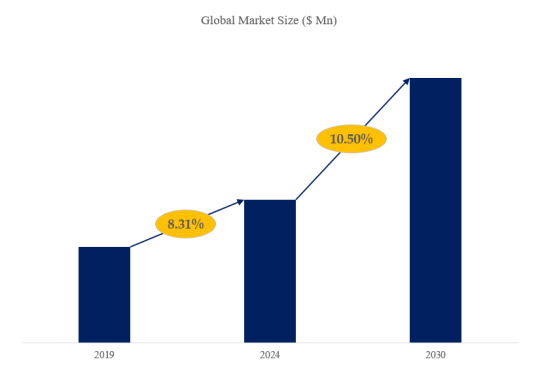
Selon QYResearch, les principaux fabricants mondiaux de Usine intelligente comprennent Siemens, ABB, Atos SE, Cisco Systems Inc., General Electric, Emerson, Bosch, Honeywell, Microsoft Corporation, IBM, etc. En 2023, les cinq premiers acteurs mondiaux détenaient une part d'environ 17.0% en termes de chiffre d'affaires.
Figure 2. Classement et part de marché des 15 premiers acteurs mondiaux de Usine intelligente (Le classement est basé sur le chiffre d'affaires de 2023, continuellement mis à jour)

The key market drivers for the Smart Factory market:
1. Increasing Demand for Automation and Optimization of Manufacturing Processes: The need to improve productivity, efficiency, and quality in manufacturing has driven the adoption of smart factory technologies.
2. Growing Focus on Reducing Operating Costs and Improving Profitability: The desire to minimize production costs, waste, and downtime through the implementation of smart factory solutions has been a significant market driver.
3. Advancements in Industrial Internet of Things (IIoT) and Connectivity: The rapid development and integration of IIoT technologies, such as sensors, cloud computing, and data analytics, have enabled the transformation of traditional factories into smart factories.
4. Shortage of Skilled Labor and Workforce Challenges: The difficulty in finding and retaining skilled manufacturing workers has led companies to invest in smart factory technologies to improve operational efficiency and productivity.
5. Stringent Regulatory Requirements and Environmental Sustainability Concerns: The increasing focus on compliance with environmental regulations and the need to reduce the carbon footprint of manufacturing operations have driven the adoption of smart factory solutions.
6. Demand for Flexible and Reconfigurable Manufacturing Systems: The need for agile and adaptable manufacturing systems that can quickly respond to changing market demands and product variations has fueled the growth of the smart factory market.
7. Increasing Adoption of Predictive and Preventive Maintenance Strategies: The recognition of the benefits of predictive and preventive maintenance, enabled by smart factory technologies, has driven their adoption to reduce downtime and maintenance costs.
8. Rising Emphasis on Product Quality, Traceability, and Supply Chain Optimization: The demand for improved product quality, enhanced traceability, and optimized supply chain operations has been a key driver for smart factory implementations.
9. Government Initiatives and Policies Supporting Industrial Digitalization: Government programs and policies aimed at promoting the adoption of Industry 4.0 and smart manufacturing technologies have contributed to the growth of the smart factory market.
10. Increasing Competitive Pressures and the Need for Operational Excellence: The competitive pressures faced by manufacturing companies to maintain a competitive edge and improve operational excellence have driven the implementation of smart factory solutions.
À propos de QYResearch
QYResearch a été fondée en 2007 en Californie aux États-Unis. C'est une société de conseil et d'étude de marché de premier plan à l'échelle mondiale. Avec plus de 17 ans d'expérience et une équipe de recherche professionnelle dans différentes villes du monde, QYResearch se concentre sur le conseil en gestion, les services de base de données et de séminaires, le conseil en IPO, la recherche de la chaîne industrielle et la recherche personnalisée. Nous société a pour objectif d’aider nos clients à réussir en leur fournissant un modèle de revenus non linéaire. Nous sommes mondialement reconnus pour notre vaste portefeuille de services, notre bonne citoyenneté d'entreprise et notre fort engagement envers la durabilité. Jusqu'à présent, nous avons coopéré avec plus de 60 000 clients sur les cinq continents. Coopérons et bâtissons ensemble un avenir prometteur et meilleur.
QYResearch est une société de conseil de grande envergure de renommée mondiale. Elle couvre divers segments de marché de la chaîne industrielle de haute technologie, notamment la chaîne industrielle des semi-conducteurs (équipements et pièces de semi-conducteurs, matériaux semi-conducteurs, circuits intégrés, fonderie, emballage et test, dispositifs discrets, capteurs, dispositifs optoélectroniques), la chaîne industrielle photovoltaïque (équipements, cellules, modules, supports de matériaux auxiliaires, onduleurs, terminaux de centrales électriques), la chaîne industrielle des véhicules électriques à énergie nouvelle (batteries et matériaux, pièces automobiles, batteries, moteurs, commande électronique, semi-conducteurs automobiles, etc.), la chaîne industrielle des communications (équipements de système de communication, équipements terminaux, composants électroniques, frontaux RF, modules optiques, 4G/5G/6G, large bande, IoT, économie numérique, IA), la chaîne industrielle des matériaux avancés (matériaux métalliques, polymères, céramiques, nano matériaux, etc.), la chaîne industrielle de fabrication de machines (machines-outils CNC, machines de construction, machines électriques, automatisation 3C, robots industriels, lasers, contrôle industriel, drones), l'alimentation, les boissons et les produits pharmaceutiques, l'équipement médical, l'agriculture, etc.
0 notes
Text
Exklusive Einblicke in die Porsche Produktion 4.0
„Die automobile Welt verändert sich ja gerade ganz massiv und wir als Porsche gestalten intensiv mit.“ Moderne Technologie revolutioniert die Art und Weise, wie Produkte hergestellt werden. Deutlich spürbar ist das in der Automobilindustrie. „Die automobile Welt verändert sich ja gerade ganz massiv und wir als Porsche gestalten intensiv mit“, sagt Albrecht Reimold, Vorstand Produktion und…
#Auto#Car#Porsche#Porsche AG#Porsche Consultin#Porsche Produktion#Porsche Produktion 4.0#Produktion#Smart Factory
0 notes
Text

Smart Factory-Digitalisierung | Nevolvis
Der Einsatz digitaler Technologie kann die Arbeitsweise von Fabriken verändern und Einnahmen generieren. Und wenn Sie Technologie in Ihrer Fertigungseinheit implementieren, wird daraus eine Smart Factory Digitalisierung. Möchten Sie wissen, wie Sie Ihre Fertigungseinheit in eine Smart Factory umwandeln können? Nehmen Sie jetzt Kontakt mit uns auf.
1 note
·
View note
Text
How do we define Smart Factory?
How do we define Smart Factory? #SmartFactory #Industry4 #digitalization #SmartProducts #SmartMobility #SmartGrid
Smart Factory and Industry 4.0 are the two sides of the same coin. Let’s look at how Smart Factory operates, Definition of Smart Factory “At the heart of Industry 4.0 is the real-time capable, intelligent, horizontal and vertical networking of people, machines, objects, and ICT systems for the dynamic management of complex systems.”, according to BITKOM, Fraunhofer IAO, Industrie 4.0 –…
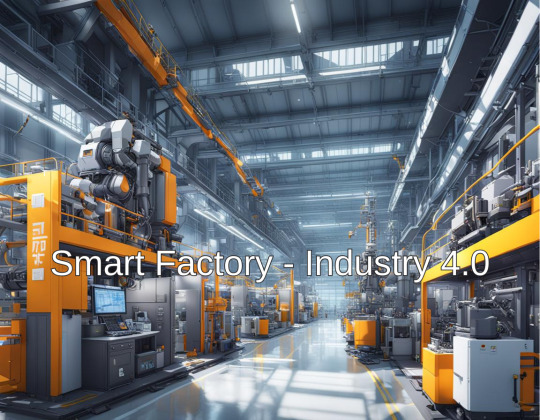
View On WordPress
0 notes
Text
Smart Manufacturing In the Digital Age

In today’s age of industrial automation, the buzz around digital transformation (DX) is undeniable. According to Gartner, 80% of manufacturing CEOs are increasing investments in digital technologies such as AI, machine learning, IoT, and data analytics, aiming to navigate economic challenges and propel growth. Yet, only 8% claim success in their digital endeavors. What’s the missing link? It’s not technology but organizational readiness that often falters.
Manufacturers embarking on this digital transformational journey must heed vital principles. Cross-functional digital transformation teams, spearheaded by smart manufacturing operations, blend expertise from engineering, supply chain, and material operations. IT becomes the linchpin, ensuring data’s reliability and security, essential to fuelling data-driven manufacturing.
Data demands strategic handling. Centralization ensures a singular truth source, while targeted collection tailored to specific manufacturing challenges optimizes resources. Equally crucial is democratizing data, delivering pertinent information to individuals — from operators to maintenance leaders — empowering precise decision-making.
However, technology’s human element cannot be ignored. HR plays a pivotal role, bridging generational gaps and ensuring everyone understands the purpose and benefits of digital transformation. Financial realism is equally paramount; ongoing costs, often underestimated, necessitate meticulous accounting to prevent implementation hurdles.

Above all, leadership must champion this shift, preserving the company’s ethos. By fostering a culture of decentralized, data-driven decision-making, organizations can harmonize tradition with technology. As we tread the path to digitalization, JR Automation, a Hitachi Group company stands as a beacon, guiding industries worldwide toward a future where innovation and tradition coexist seamlessly.
In summary, cross-functional teams, IT partnerships, HR support, and visionary leadership are critical to achieving a seamless and culturally aligned transition and ensuring the success of digital transformation initiatives in manufacturing.
Explore the surprising factors that drive successful digital transformation in manufacturing and best practices for overcoming organizational hurdles and harnessing cross-functional teamwork to maximize data-driven decision-making.
Discover how Hitachi is enabling data-driven manufacturing automation to achieve sustainability and profitability
#smart manufacturing#smart factory#industry 4.0#industrial digitalization#digital transformation#sustainable manufacturing#manufacturing digitalization#sustainability
0 notes